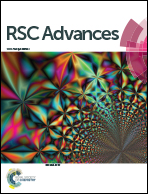Visible and near-infrared electrochromic thiophene–diketopyrrolopyrrole polymers†
Abstract
A series of low bandgap polymers containing thiophene and diketopyrrolopyrrole (DPP) units were synthesized and their electrochromic (EC) properties were investigated. It was found that the ratio (Rda) of thiophene to DPP units correlates to the EC properties, in particular optical contrast (ΔT) and coloration efficiency (CE) in the visible and near-infrared spectral regions (e.g., 1310 nm). At the wavelength of 1310 nm, the CE of polymer P2 (Rda = 3 : 1) and ΔT of polymer P4 (Rda = 4 : 1) reached the high values of 1383 cm2 C−1 and 81.5%, respectively. Polymer P3 (Rda = 3.5 : 1) had a relatively short switching time of 1.24 s from the doped state to neutral state. Colors of polymer films changed reversibly between green or blue (neutral state) and grey (doped state) upon the redox cycling.



 Please wait while we load your content...
Please wait while we load your content...